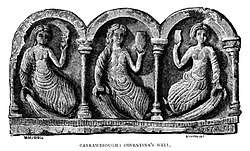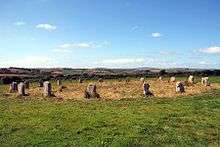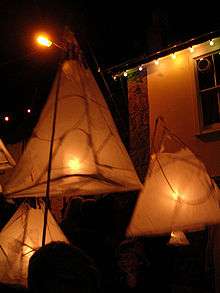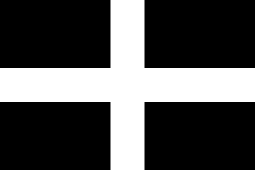Cornish mythology
Cornish mythology is the folk tradition and mythology of the Cornish people. It consists partly of folk traditions developed in Cornwall and partly of traditions developed by Britons elsewhere before the end of the first millennium, often shared with those of the Breton and Welsh peoples. Some of this contains remnants of the mythology of pre-Christian Britain.
| Part of a series on |
| Celtic mythology |
|---|
 |
| Gaelic mythology |
| Brythonic mythology |
| Concepts |
| Religious vocations |
| Festivals |
|

There is much traditional folklore in Cornwall, often tales of giants, mermaids, Bucca, piskies or the 'pobel vean' (little people.) These are still popular today, with many events hosting a 'droll teller'[1] to tell the stories: such myths and stories have found much publishing success, particularly in children's books. The fairy tale Jack the Giant Killer takes place in Cornwall. Many early British legends associate King Arthur with Cornwall, putting his birthplace at Tintagel, the court of King Mark of Cornwall, uncle of Tristan and husband of Iseult, the most famous Cornish lovers.
Overview
Cornwall shares its ancient cultural heritage with its 'Brythonic cousins' Brittany and Wales, as well as Ireland and parts of England such as neighbouring Devon. Many ancient tales of the Bards, whether the Arthurian Cycle, Tristan and Iseult or the Mabinogion take place in the ancient kingdom of Cerniw between Greater and Lesser Britains with a foot on either side of the 'British Sea' Mor Brettanek/Mor Breizh.
Part of Cornish mythology is derived from tales of seafaring pirates and smugglers who thrived in and around Cornwall from the early modern period through to the 19th century. Cornish pirates exploited both their knowledge of the Cornish coast as well as its sheltered creeks and hidden anchorages. For many fishing villages, loot and contraband provided by pirates supported a strong and secretive underground economy in Cornwall.[2]
Legendary creatures that appear in Cornish folklore include buccas, knockers, Giants and piskies.[3] Tales of these creatures are thought to have developed as supernatural explanations for the frequent and deadly cave-ins that occurred during 18th century Cornish tin mining, or else a creation of the oxygen-starved minds of exhausted miners who returned from the underground.
The knocker or bucca (Cornish) is the Welsh and Cornish equivalent of Irish leprechauns and English and Scottish brownies. About two feet tall and grizzled, but not misshapen, they live beneath the ground. Here they wear tiny versions of standard miner's garb and commit random mischief, such as stealing a miner's unattended tools and food - they were often cast a small offering of food – usually the crust of a pasty – to appease their malevolence.
Many landscape features, from the barren granite rock features on Bodmin Moor, to the dramatic cliff seascape, to the mystical form of St Michael's Mount are explained as the work of Giants and English tales such as the early eighteenth century Jack the Giant Killer may recall much older British folk traditions recorded elsewhere in medieval Welsh language manuscripts and closely related to the folk traditions of Dartmoor in neighbouring Devon.
Old Michaelmas Day falls on 11 October (10 October according to some sources). According to an old legend, blackberries should not be picked after this date. This is because, so British folklore goes, Satan was banished from Heaven on this day, fell into a blackberry bush and cursed the brambles as he fell into them. In Cornwall, a similar legend prevails, according to which the devil urinated on them.[4]
- The midnight washerwomen
Les Lavandières or the Midnight Washerwomen are three old laundresses in Celtic mythology. In Wales and Cornwall a passerby must avoid being seen by the washerwomen. If they do get seen however, they are required to help wring out the sheets. If they twist the sheets in the same direction as the washerwomen, the individual's arms will be wrenched from their sockets and they will get pulled into the wet sheets and killed instantly. If, however, they twist in the opposite direction, the washerwomen are required to grant the person three wishes.
- Weather lore
"Mist from the hill / Brings water for the mill; / Mist from the sea /Brings fine weather for me."[5] "Lundy plain, Sign of rain" (current in north Cornwall where Lundy Island is normally visible).
Enys Tregarthen
Nellie Sloggett of Padstow devoted much of her attention to Cornish folklore and legend. She collected and recorded many stories about the Piskey folk, fairies of Cornish myth and legend. She published most of her works in this category under her better-known pen-name of Enys Tregarthen.[6]
- Books
- The Doll Who Came Alive (1973) ISBN 0-381-99683-2
- Pixie Folklore & Legends (reprinted 1995) ISBN 0-517-14903-6
- Padstow's Faery Folk (Paperback)
- North Cornwall Fairies and Legends. London: Wells Gardner, Darton & Co. 1906 – via Internet Archive.
- The House of the Sleeping Winds and Other Stories (1911)
- The White Ring (1949)
North Cornwall
Dozmary Pool is identified by some people with the lake in which, according to Arthurian legend, Sir Bedivere threw Excalibur to The Lady of the Lake.[7]:11 Another legend relating to the pool concerns Jan Tregeagle.
The Beast of Bodmin has been reported many times but never identified with certainty.
- Doom Bar
According to legend, the Mermaid of Padstow created the Doom Bar as a dying curse, after being shot by a sailor. However, there are many different versions of the story and the precise details are unclear. Some versions start by stating that she used to guide ships up the estuary and others that she would visit and spy upon ships in harbour, yet more tell of how she used to sit upon a rock at Hawkers Cove. She then met a man, and one fell in love with the other. One version explains that she was love sick, and tried to lure him beneath the waves, however he escaped by shooting her.[8] Another version suggested the man, Tristram Bird, fell in love with her and asked her to marry him, though she refused. In his rage he shot her.[9] Another suggestion is that a fisherman, Tom Yeo, shot her because he thought she was a seal. The ending of the legend is generally similar. With her dying breath, she levelled a curse at Padstow, or at the harbour itself, stating that the harbour will be desolate or unsafe. With that, a great storm came, wrecking many boats and creating the great sand bank known as the Doom Bar.
Penwith

Within the bounds of Gulval parish lies the disused Ding Dong mine, reputedly one of the oldest in Cornwall. Popular local legend claims that Joseph of Arimathea, a tin trader, visited the mine and brought a young Jesus to address the miners, although there is no evidence to support this.[10]
At Zennor there is a legend of the Mermaid of Zennor and at Mousehole, Tom Bawcock is a legendary fisherman from the village who according to legend risked his life to go out and fish and managed to come back with enough fish to feed the village until the storm was over. All the fish was put into a big pie, and the pie called "Stargazy pie".
The Merry Maidens stone circle at St Buryan: the local myth about the creation of the stones suggests that nineteen maidens were turned into stone as punishment for dancing on a Sunday. (Dans Maen translates as Stone Dance.) The pipers, two megaliths some distance north-east of the circle, are said to be the petrified remains of the musicians who played for the dancers. A more detailed story explains why the Pipers are so far from the Maidens - apparently the two pipers heard the church clock in St Buryan strike midnight, realised they were breaking the sabbath, and started to run up the hill away from the maidens who carried on dancing without accompaniment. These petrifaction legends are often associated with stone circles, and is reflected in the folk names of some of the nearby sites, for example, the Tregeseal Dancing Stones, the Nine Maidens of Boskednan, as well as the more distant Hurlers and Pipers on Bodmin Moor.
See also
- Breton mythology
- Cornish festivals
- Peter and the Piskies: Cornish Folk and Fairy Tales
- Culture of Cornwall
- List of Cornish saints
- Arthur & Celliwig - PenDragon; 'Bear Chief Dragon' of the Britons
- Tristan and Iseult - a Cornish love story
- Lyonesse & Ys - the Cornish & Breton Atlantis
- Jan Tregeagle
- William Henry Paynter
- Matter of Britain
- Corineus - mythical founder of Cornwall
- Cormoran - the Giant and his wife of St Michael's Mount
- Hunting of Twrch Trwyth - the Cornish Boar of Welsh legend
- Jack the Giant Killer
- Blunderbore
- Bucca - the Spirit of the Sea
- Mark of Cornwall alias Conomor - the mythical and historical king; 'Hound of the Sea'
- Magnus Maximus / Macsen Wledig - historical late Roman emperor and mythical founder of Brittany
- History of Brittany - the brother nation over the sea
- Welsh Mythology
References
- O'Connor, Mike (2010). Cornish Folk Tales. Stroud: The History Press. ISBN 978-0-7524-5066-7. OCLC 865081421.
- Andrews, Robert; Brown, Jules; Humphreys, Rob; Lee, Phil; Reid, Donald; Whitfield, Paul (2006), The Rough Guide to Britain, Rough Guides, ISBN 978-1-84353-686-4
- Steves, Rick (2007), Rick Steves' England 2008, Avalon Travel, p. 253, ISBN 978-1-59880-097-5
- Taylor, Rob (7 October 2010). "Michaelmas Traditions". Black Country Bugle. Local World. Archived from the original on 30 September 2015. Retrieved 29 September 2015.
- Holloway, John, ed. (1987). The Oxford Book of Local Verses. Oxford: Oxford University Press. p. 104. ISBN 0-19-214149-X. OCLC 463975437.
- "Introduction to Cornish Fairy Folk Tales". Celtic, Tolkien, and Arthurian Graphics, and Cornish Folklore. William Rowe. Archived from the original on 30 November 2009. Retrieved 15 September 2009.
- Tilley, Christopher (1995). "Rock as resources: landscapes and power" (PDF). Cornish Archaeology. 34: 5–57.
- "Padstow: Information about Padstow". Into Cornwall Guide. Archived from the original on 14 March 2009. Retrieved 4 February 2009.
- "About Piran Pewter". Piran Pewter. Archived from the original on 9 May 2008. Retrieved 4 February 2009.
- Matthews, John, ed. (1991). A Glastonbury Reader: Selections From the Myths, Legends and Stories of Ancient Avalon. London: Aquarian Press. ISBN 0-85030-999-9. OCLC 917210115.
Further reading
- Addicoat, Ian; Buswell, Geoff (2003). Mysteries of the Cornish Coast: legends, ghosts and extraordinary events from Cornwall's south-west peninsula. Tiverton: Halsgrove. ISBN 1-84114-255-7.
- Baring-Gould, Sabine (1899). A Book of the West: Being an Introduction to Devon and Cornwall. II: Cornwall. London: Methuen – via Internet Archive.
- Bottrell, William. Traditions and Hearthside Stories of West Cornwall. 3 vols:
- Bottrell, William (1870). Traditions and Hearthside Stories of West Cornwall. Penzance: W. Cornish (for the author) – via Google Books.
- Bottrell, William (1873). Traditions and Hearthside Stories of West Cornwall. Second Series. Penzance: Beare and Son (for the author) – via Internet Archive.
- Bottrell, William (1880). Stories and folk-lore of West Cornwall. Third Series. Penzance: F. Rodda (for the author) – via Internet Archive.
- Couch, Jonathan (1871). The History of Polperro: A Fishing Town on the South Coast of Cornwall. Truro: W. Lake – via Google Books. (Reprinted: Polperro Heritage Press, 2004; ISBN 978-0-9544233-7-7, OCLC 867913690)
- Quiller-Couch, Mabel (1914). Cornwall's Wonderland. London: J.M. Dent & Sons – via Internet Archive. (Contents: How Corineus fought the chief of the giants.--The giant of St Michael's Mount.--The legend of the Tamar, the Tavy, and the Taw.--The strange story of Cherry Honey.--The fairies on the Gump.--The fairy ointment.--The exciting adventure of John Sturtridge.--The true story of Anne and the fairies.--Barker and the Buccas.--Lutey and the mermaid.--The wicked spectre.--The story of the lovers' cove.--The silver table.--Cruel Coppinger, the Dane.--Madge Figgy, the wrecker.--How Madge Figgy got her pig.--The story of Sir Tristram and La Belle Isoult.)
- Courtney, Margaret Ann (1890). Folklore and Legends of Cornwall.
- Ditmas, Edith (1970). Tristan and Iseult in Cornwall. Gloucester: Forrester Roberts.
- Evans-Wentz, W.Y. (1911). The Fairy-Faith in Celtic Countries. London: Oxford University Press – via Internet Archive.
- Gary, Gemma (2011). Traditional Witchcraft: A Cornish Book of Ways (Rev. 2nd ed.). Troy Books. ISBN 978-0-9561043-4-2. OCLC 819718908.
- Hunt, Robert (1995). Cornish Fairies. St Day: Tor Mark Press. ISBN 0-85025-351-9. Selected from:
- Hunt, Robert (1865). Popular Romances of the West of England, or, The drolls, traditions, and superstitions of old Cornwall. First Series. London: John Camden Hotten – via Internet Archive.
- Hunt, Robert (1865). Popular Romances of the West of England, or, The drolls, traditions, and superstitions of old Cornwall. Second Series. London: John Camden Hotten – via Internet Archive.
- James, Beryl (1988). Tales of the Tinners' Way. Redruth: Dyllansow Truran. ISBN 1-85022-042-5.
- Jenkin, A.K. Hamilton (1933). Cornwall and the Cornish: The story, religion and folk-lore of ’The Western Land.
- Lach-Szyrma, W.S. (1882). "M. Sebillot's System as applied to Cornish Folk-lore". Transactions of the Penzance Natural History and Antiquarian Society. New Series: 132–150.
- Matthews, John Hobson (1892). "Legendary Lore". A History of the Parishes of Saint Ives, Lelant, Towednack, and Zennor, in the County of Cornwall. London: Elliot Stock. pp. 379-392 – via Internet Archive. (Reprinted: St Ives: St. Ives Trust and St. Ives Library, 2003)
- Paynter, William H.; Semmens, Jason (2008). The Cornish Witch-finder: The Witchery, Ghosts, Charms and Folklore of Cornwall. St. Agnes: Federation of Old Cornwall Societies. ISBN 978-0-902660-39-7. OCLC 407137778.
- Semmens, Jason (2004). The Witch of the West: Or, The Strange and Wonderful History of Thomasine Blight. Plymouth: Jason Semmens. ISBN 978-0-9546839-0-0. OCLC 62263902.
- Semmens, Jason (1998). "A Case of Witchcraft in Camborne during the Late Seventeenth Century?". Old Cornwall. 12 (3): 3–4. ISSN 1741-0932.
- Semmens, Jason (2000). "The Usage of Witch-Bottles and Apotropaic Charms in Cornwall". Old Cornwall. 12 (6): 25–30. ISSN 1741-0932.
- Semmens, Jason (2003). "The Magus in Cornwall: an Unknown Chapter in the Life of Francis Barrett, F.R.C.". Old Cornwall. 13 (1): 18–21. ISSN 1741-0932.
- Semmens, Jason (2004). "An Account of One Ann Jeffries: Notes on the Background to the Curious Case of the Maid of St. Teath". Old Cornwall. 13 (3): 10–15. ISSN 1741-0932.
- Semmens, Jason (April 2005). "'Whyler Pystry': a Breviate of the Life and Folklore-Collecting Practices of William Henry Paynter (1901–1976) of Callington, Cornwall". Folklore. 116 (1): 75–94. doi:10.1080/0015587052000337734. JSTOR 30035240.
- Semmens, Jason (2005). "A Cure from the Cunning". Cornish World. 42: 62–67.
- Semmens, Jason (Autumn 2005). "Old and a Trouble: Notes on the Life of Granny Boswell". Meyn Mamvro. 58: 20–22.
- Semmens, Jason (2006). "Tales of Cornish Witches". Old Cornwall. 13 (7): 22–27. ISSN 1741-0932.
- Semmens, Jason (2008). "Folk-magic in East Cornwall: a Nineteenth-century Conjuror's Archive from North Tamerton". Old Cornwall. 13 (10): 20–26. ISSN 1741-0932.
- Semmens, Jason (2009). "On the Origin of 'Peller'". Old Cornwall. 14 (1): 43–50. ISSN 1741-0932.
